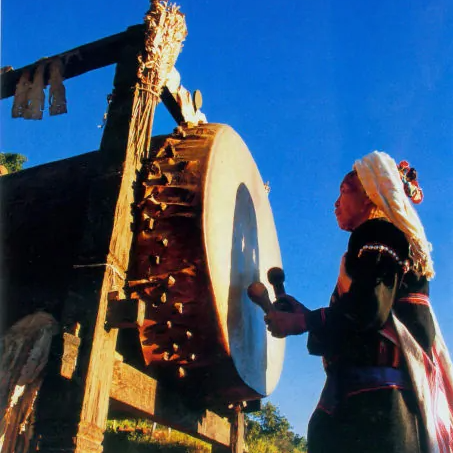shengu overview
 Shengu (Pinyin: Shén gǔ) is also known as Lama Drum. It is a percussion instrument used by Tibetan and Mongolian lama monasteries. Popular in Tibet, Qinghai, Gansu, Sichuan, Yunnan, Inner Mongolia and other provinces.
Shengu (Pinyin: Shén gǔ) is also known as Lama Drum. It is a percussion instrument used by Tibetan and Mongolian lama monasteries. Popular in Tibet, Qinghai, Gansu, Sichuan, Yunnan, Inner Mongolia and other provinces.Drum frame wooden round, covered with sheepskin or cowhide on both sides. Sizes vary, the diameter of the drum face is about 40 cm, and the largest is 90 cm. The drum frame is about 21 cm thick. The drum surface is painted with reddish brown paint. The drum frame is decorated with various colored patterns. The lower end is connected with a wooden drum handle, and the handle is more than 60 cm long. The height is about 120 cm. The drum is made of rattan, with a curved shape, the head is covered with sheepskin or cloth, and the handle is made of wood. The grip part is engraved.
When playing, the player sits on the ground, stands the drum handle on the ground or inserts it on the drum stand, supports the long handle with the left hand, and plays the drum with the right hand; it can also be played during the march of the honor guard band. In Mongolian areas, when lamas dance the chama, they dance and play it. It has been used in song and dance performances, and can be worn cross-body on the chest to play. It is also used for Tibetan opera accompaniment.
- Pinyin:Shén gǔ
- shape:drum frame wooden round
- play:The player sits on the ground
- nickname:lama drum
overview of other similar instruments
- sanyanxiao overview
- Daguangxian overview
- Leiqin overview
- hahao overview
- yandundagu overview
- Han Xiaozheng overview
- Fang Xiang overview
- guanzi overview
- zhuqin (Dao Qin) overview
- zhuiqin overview
- bangzi overview
- three-stringed piano overview
- Gehu overview
- xiao overview
- xiaokonghou overview
- Konghou overview
- Sheng overview
- suona overview
- hulusi overview
- gushao overview
 渝公网安备 50010702504639号
渝公网安备 50010702504639号